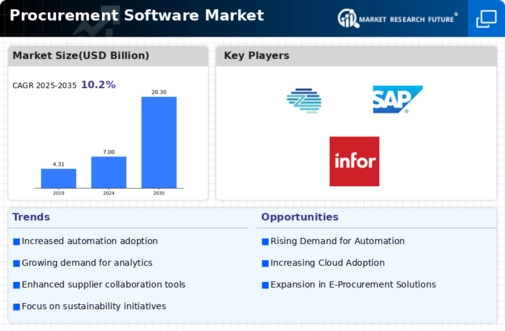Market Share
Procurement Software Market Share Analysis
In the fiercely competitive landscape of the procurement software market, companies employ various market share positioning strategies to establish a strong foothold and gain a competitive edge. One prevalent strategy involves differentiation, where companies strive to distinguish their procurement software offerings from competitors through unique features, functionalities, and value propositions. By focusing on innovation, user experience, and addressing specific industry needs, companies aim to carve out a niche and attract a dedicated customer base, thereby enhancing their market share.
Strategic partnerships and collaborations are integral components of market share positioning in the procurement software sector. Companies often form alliances with other organizations to expand their product offerings, enhance capabilities, or access new markets. These partnerships can lead to the development of integrated solutions that address a broader spectrum of procurement needs. By aligning with complementary service providers or industry leaders, companies position themselves to capture a larger share of the market and offer more comprehensive solutions to their customers.
Acquisitions and mergers are impactful strategies employed by companies to bolster their market share in the procurement software industry. Through strategic acquisitions, companies can gain access to new technologies, customer bases, or niche markets. Merging with or acquiring competitors enables companies to consolidate resources, eliminate redundancies, and strengthen their overall market position. This strategy is particularly effective for companies looking to rapidly expand their presence and achieve economies of scale in a competitive market environment.
A customer-centric approach is vital for securing and expanding market share in the procurement software sector. Companies that prioritize understanding and meeting the unique needs of their customers can build strong and lasting relationships. By offering personalized solutions, providing excellent customer support, and continuously improving their products based on customer feedback, companies can cultivate loyalty and increase their market share. A satisfied customer base not only contributes to revenue through repeat business but also serves as a valuable asset in attracting new customers through positive word-of-mouth.
Price positioning is a crucial strategy that companies employ to gain a competitive advantage in the procurement software market. Some companies focus on offering cost-effective solutions to appeal to budget-conscious customers, aiming to capture market share by providing value for money. Others position themselves as premium providers, emphasizing advanced features, superior performance, and dedicated support services. This strategy targets customers seeking top-tier solutions and are willing to invest more for enhanced capabilities. By strategically determining their price positioning, companies can cater to specific market segments and optimize their market share.
Continued investment in research and development is a strategic imperative for companies aiming to maintain or expand their market share in the rapidly evolving procurement software market. The introduction of new features, functionalities, and technological advancements keeps offerings competitive and aligns them with the evolving needs of customers. By staying at the forefront of innovation, companies can attract new customers, retain existing ones, and solidify their market share against competitors.
Geographical expansion is a market share positioning strategy often employed by companies looking to tap into new markets and regions. By understanding the unique requirements of different geographic areas, companies can tailor their procurement software offerings to meet specific local needs. This strategy allows companies to diversify their customer base, reduce dependency on specific markets, and position themselves as global leaders in the procurement software space.






Leave a Comment